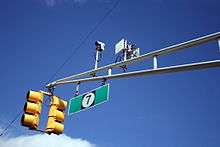Meadowlands Adaptive Signal System for Traffic Reduction
MASSTR, the' Meadowlands Adaptive Signal System for Traffic Reduction, is an adaptive traffic control system commissioned by the New Jersey Meadowlands Commission (NJMC) for a forty square mile region in the New Jersey Meadowlands. Adaptive Signal Control Technology (ASCT) adjusts the signal timings based upon the flow of traffic instead of utilizing fixed or actuated timings.[1] This regional intelligent transportation system (ITS) incorporates more than 128 traffic signals and serves more than 400,000 vehicles daily. MASSTR is one of a number of ITS projects deployed throughout New Jersey.[2] MASSTR is the fourth-largest deployment of SCATS (Sydney Coordinated Adaptive Traffic System) in the United States.[3]

Adaptive Signal Control Technology continuously coordinates and optimizes traffic signal timings rather than utilizing fixed or actuated timings. Signal timings are optimized across jurisdictional boundaries with a central computer system at a Traffic Management Center in the NJMC Complex. The Meadowlands adaptive system utilizes adaptive traffic signal control software, wireless and fiber optic communications, and vehicle detection cameras, which are coordinated at an NJMC Traffic Management Center.
Installation of the first phase began and was completed in 2012.[4] Construction of phases 2 and 3 were completed in the summer of 2013. All phases are planned to be completed by Summer 2014.[5]
An expansion of the project for the NJ Department of Transportation is currently underway [6] to mitigate future congestion from the closure of the Pulaski Skyway for reconstruction. This expansion will include signals along U.S. 1/9 Truck in Kearny and Jersey City, NJ and NJ Rt. 440 in Jersey City.[7] This expansion of the Meadowlands Adaptive Signal System is the first NJDOT-owned and operated Adaptive Traffic Signal System.[8] The closure of the Pulaski Skyway will affect 67,000 daily crossings.[9]
NJDOT and NJMC expect the Adaptive Traffic Signal Control technology will aid in maximizing the capacity and efficiency of existing travel lanes to handle increased traffic demands due to the Pulaski Skyway reconstruction project when northbound traffic will need to be diverted to alternate routes.[10]
See also
References
- ↑ Federal Highway Administration, "Adaptive Signal Control," http://www.fhwa.dot.gov/everydaycounts/technology/adsc/
- ↑ Intelligent Transportation Society of New Jersey, "New Jersey's ITS deployments," http://transportation.njit.edu/itsnj/resources.htm
- ↑ "TransCore's $3M deal", May 22, 2012, http://www.itsinternational.com/event-news/its-america-2012/transcore-wins-major-scats-deployment-contract/#sthash.tbLOlzUy.dpuf
- ↑ Ma, Myles, "Project to link Meadowlands traffic lights takes first step," September 12, 2012" http://www.nj.com/bergen/index.ssf/2012/09/project_to_link_meadowlands_traffic_lights_takes_first_step.html
- ↑ Grant, Megan, "Meadowlands traffic signal project enters new phase," May 30, 2013
- ↑
- ↑
- ↑ Frassinelli, Mike, The Star-Ledger, "N.J. Turnpike extension to open shoulder as extra lane during Pulaski Skyway repairs," September 24, 2013, http://www.nj.com/news/index.ssf/2013/09/nj_turnpike_extension_to_open_shoulder_as_extra_lane_during_pulaski_skyway_repairs.html
- ↑ New Jersey Department of Transportation, "Pulaski Skyway Overview," http://www.state.nj.us/transportation/works/studies/pulaski/
- ↑ Vena, Joseph R., The Jersey Journal, "'Adaptive' signals will speed up traffic in Jersey City and Kearny during Pulaski Skyway construction," September 5, 2013
Further reading
- "N.J. Turnpike extension to open shoulder as extra lane during Pulaski Skyway repairs". NJ.com. 2013-09-24. Retrieved 2014-01-30.
- "'Adaptive' signals will speed up traffic in Jersey City and Kearny during Pulaski Skyway construction". NJ.com. 2013-09-05. Retrieved 2014-01-30.
- "During Pulaski Skyway closure, traffic lights to be adjusted on local roads". NJ.com. 2013-09-05. Retrieved 2014-01-30.
- "Traffic Technology Today". Traffic Technology Today. Retrieved 2014-01-30.
- "NJMC to deploy adaptive signal control in Hackensack Meadowlands". Road Traffic Technology. Retrieved 2014-01-30.
- "TransCore's $3M deal". ITS International. 2012-05-22.
- "Meadowlands traffic signal project enters new phase, many South Bergen County cameras to be activated in June". NorthJersey.com. 2013-05-30.
- "New Jersey Meadowlands Commission Deploys TransCore's Adaptive Signal Control System" (Press release). BusinessWire. May 21, 2012.